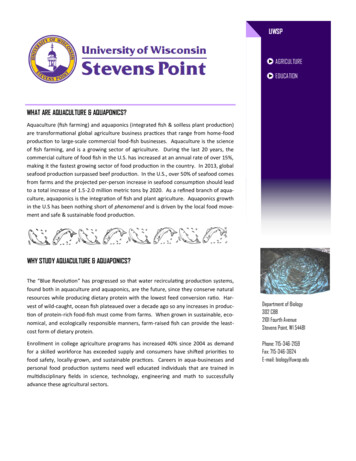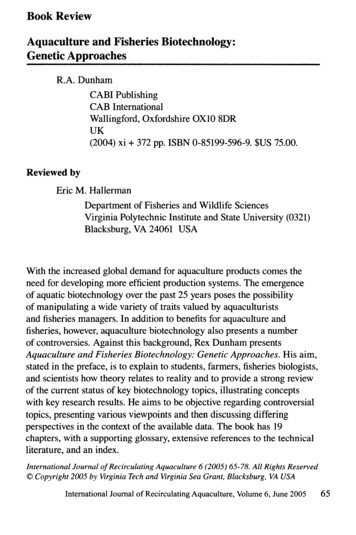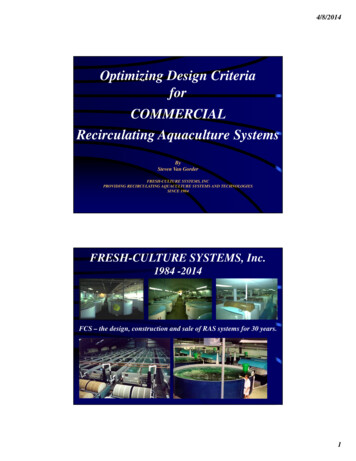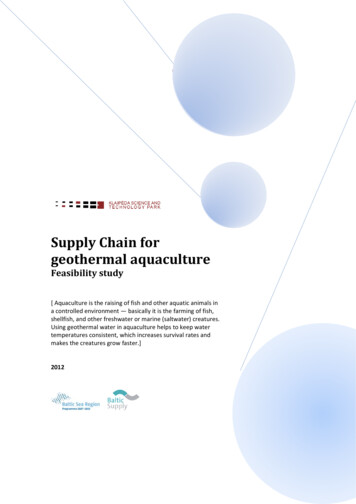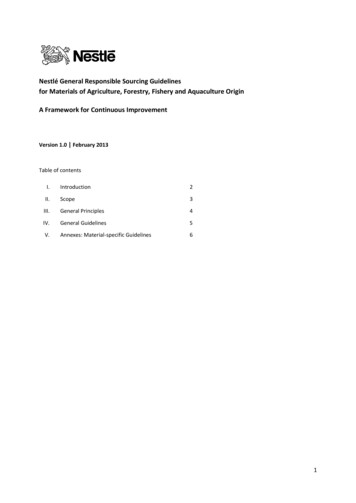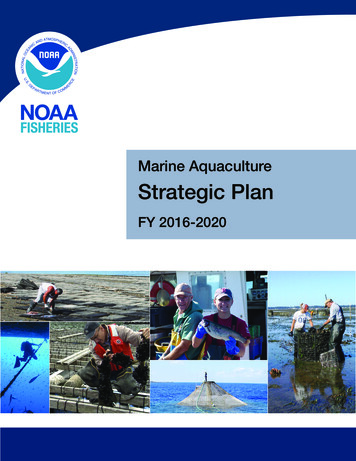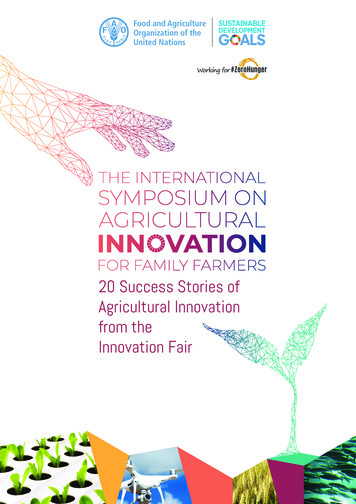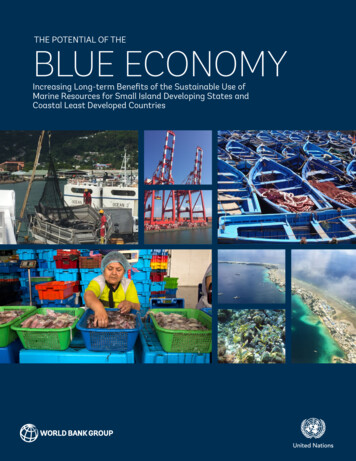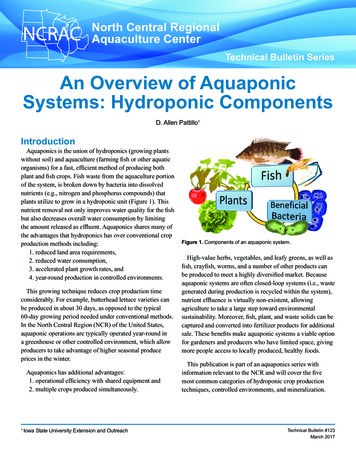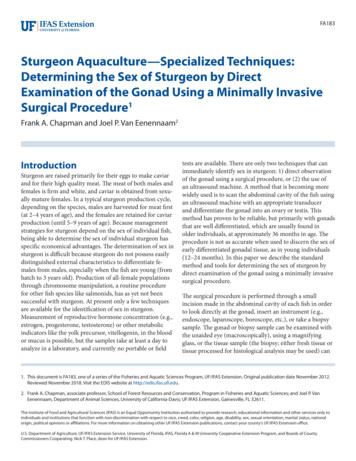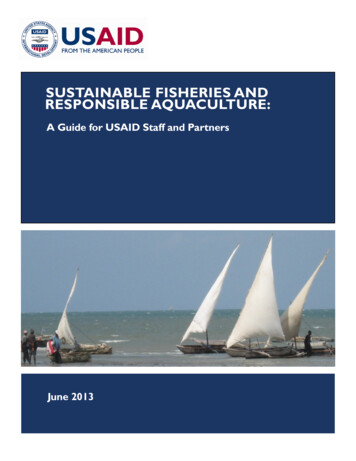
Transcription
SUSTAINABLE FISHERIES ANDRESPONSIBLE AQUACULTURE:A Guide for USAID Staff and PartnersJune 2013
ABOUT THIS GUIDEGOALThis guide provides basic information on how to design programs to reform capture fisheries (alsoreferred to as “wild” fisheries) and aquaculture sectors to ensure sound and effective development,environmental sustainability, economic profitability, and social responsibility. To achieve these objectives,this document focuses on ways to reduce the threats to biodiversity and ecosystem productivity throughimproved governance and more integrated planning and management practices. In the face of foodinsecurity, global climate change, and increasing population pressures, it is imperative that developmentprograms help to maintain ecosystem resilience and the multiple goods and services that ecosystemsprovide. Conserving biodiversity and ecosystem functions are central to maintaining ecosystem integrity,health, and productivity.The intent of the guide is not to suggest that fisheries and aquaculture are interchangeable: these sectorsare unique although linked. The world cannot afford to neglect global fisheries and expect aquacultureto fill that void. Global food security will not be achievable without reversing the decline of fisheries,restoring fisheries productivity, and moving towards more environmentally friendly and responsibleaquaculture. There is a need for reform in both fisheries and aquaculture to reduce their environmentaland social impacts.USAID’s experience has shown that well-designed programs can reform capture fisheries management,reducing threats to biodiversity while leading to increased productivity, incomes, and livelihoods. Agencyprograms have focused on an ecosystem-based approach to management in conjunction with improvedgovernance, secure tenure and access to resources, and the application of modern management practices.Such programs contribute to broader development goals, including food security, adaptation to climatechange, biodiversity conservation, improved governance and rule of law, poverty reduction, populationand family planning, and sound economic growth.USAID’s work in these fields has also shown that well-designed programs can reform the aquaculturesector, reducing threats to biodiversity and the environment while contributing to sound economic growth,food security, increased trade, livelihoods, and foreign trade.The guide addresses the following questions: Why is it essential for reform to focus on maintaining ecosystem resilience and biodiversity,especially in light of global climate change and other global stressors?Why is it essential for reform to focus on sustainability and responsibility?What should a USAID manager know to design, implement, manage, and evaluate capture fisheriesand aquaculture programs?How does one design activities to ensure that sustainable development goals are addressed usingenvironmentally responsible practices?What are the recognized best practices for sustainable fisheries and responsible aquaculture?COVER PHOTO:A small-scale fisheries landing site in Bagamoyo District of Tanzania. Photo Credit: Kathy CastroThis publication was produced for review by the United States Agency for International Development.It was prepared by the University of Rhode Island/Coastal Resources Center, in cooperation with USAIDtechnical staff and partners.
SUSTAINABLE FISHERIES ANDRESPONSIBLE AQUACULTURE:A Guide for USAID Staff and PartnersJune 2013DISCLAIMERThe authors’ views expressed in this publication do not necessarily reflect the views of the United StatesAgency for International Development or the United States Government.This guide is made possible by the generous support of the American people through the United StatesAgency for International Development (USAID). It was funded through Cooperative Agreement No.EPP-A-00-04-00014-00 to the University of Rhode Island.
AUDIENCESThis guide is intended primarily for USAID staff and implementing partners, but should also be useful toa broader audience, including multiple stakeholders within and across sectors.CONTENTThis guide addresses capture fisheries and aquaculture in separate sections, except for the discussion ofpost-harvest issues where many of the topics are common to both sectors. In practice, capture fisheriesand aquaculture are usually dealt with as separate sectors. However, greater attention needs to be paidto the real and potential interactions between the two sectors, especially negative impacts of aquacultureon the productivity of capture fisheries. Greater attention must also be given to the growing demand forwater, the loss of biodiversity, and the encroachment and ecological degradation from coastal and inlanddevelopment. Much of the capture fisheries discussion focuses on coastal and marine fisheries. However,many of the approaches and principles presented apply as well to freshwater and inland fisheries found inmost of the world’s lakes, rivers, and seasonal water bodies.The fisheries section of the guide focuses on nearshore marine and inland fisheries, as this segment of theindustry employs more people and comprises a larger percentage of total catch, by weight and value, inmost developing countries. The emphasis in the guide is on small-scale fisheries. That said, in many casesit is impossible to address problems of the small-scale sector without including analysis and simultaneousreforms in the large-scale industrial sector.The aquaculture section concentrates on reforming the sector for environmental, financial, and socialsustainability, with an emphasis on food production for the poor and the utilization of local or nativespecies. The introductory section also emphasizes the important linkages of capture fisheries andaquaculture to other sectors such as biodiversity conservation, economic growth, food security, and publichealth, as well as governance reform that supports participatory democracy and conflict mitigation.For more information or feedback on this Guide, please contact:waterteam@usaid.govACKNOWLEDGEMENTSThe guide was prepared under the direction of USAID technical staff, including Richard Volk andBarbara Best of the Bureau for Economic Growth, Education and Environment (E3), and Harry Rea ofthe Bureau for Food Security (BFS). We would like to acknowledge the individuals who have assisted inpreparing and writing the document, especially Maria Haws from the University of Hawaii at Hilo andKathy Castro, Jim Tobey, Lesley Squillante, Bob Bowen, and Brian Crawford from the University ofRhode Island. Also, many thanks for constructive and thoughtful inputs and review comments of earlierversions from colleagues at the Department of State, National Oceanic and Atmospheric Administration,WorldFish Center, The Nature Conservancy, and World Wildlife Fund, among others.
CONTENTSPREFACE . . . . . . . . . . . . . . . . . . . . . . . . . . . . . . . . . . . . . . . . . . . . . . . viiiI. INTRODUCTION. . . . . . . . . . . . . . . . . . . . . . . . . . . . . . . . . . . . . . . . . . . . . . . . . . 11.0AN OVERVIEW OF FISHERIES AND AQUACULTURE . . . . . . . . . . . . . . . . . . . . . 2CAPTURE OR WILD FISHERIES . . . . . . . . . . . . . . . . . . . . . . . . . . . . . . . . . . . . . 2AQUACULTURE . . . . . . . . . . . . . . . . . . . . . . . . . . . . . . . . . . . . . . . . . . . . . 32.0 USAID’S ROLE IN FISHERIES AND AQUACULTURE . . . . . . . . . . . . . . . . . . . . . . 4SOURCES FOR MORE INFORMATION . . . . . . . . . . . . . . . . . . . . . . . . . . . . . . . . . 53.0 THE NEED FOR REFORM . . . . . . . . . . . . . . . . . . . . . . . . . . . . . . . . . . . . 6CAPTURE FISHERIES . . . . . . . . . . . . . . . . . . . . . . . . . . . . . . . . . . . . . . . . . . . 7AQUACULTURE . . . . . . . . . . . . . . . . . . . . . . . . . . . . . . . . . . . . . . . . . . . . . 8INTEGRATED APPROACHES TO MANAGEMENT . . . . . . . . . . . . . . . . . . . . . . . . . . . . 9SOURCES FOR MORE INFORMATION . . . . . . . . . . . . . . . . . . . . . . . . . . . . . . . . . 94.0 CONTRIBUTIONS TO OTHER SECTORS . . . . . . . . . . . . . . . . . . . . . . . . . . 11BIODIVERSITY CONSERVATION . . . . . . . . . . . . . . . . . . . . . . . . . . . . . . . . . . . . 11ECONOMIC GROWTH, ENTERPRISE DEVELOPMENT, AND PUBLIC-PRIVATE PARTNERSHIPS . . . 11GENDER AND MARGINALIZED GROUPS . . . . . . . . . . . . . . . . . . . . . . . . . . . . . . . 12POPULATION, HEALTH AND HIV/AIDS . . . . . . . . . . . . . . . . . . . . . . . . . . . . . . . . 13GLOBAL CLIMATE CHANGE . . . . . . . . . . . . . . . . . . . . . . . . . . . . . . . . . . . . . . 14DISASTER MITIGATION AND RESPONSE . . . . . . . . . . . . . . . . . . . . . . . . . . . . . . . 15FOOD SECURITY AND NUTRITION . . . . . . . . . . . . . . . . . . . . . . . . . . . . . . . . . . 17DEMOCRACY AND GOVERNANCE . . . . . . . . . . . . . . . . . . . . . . . . . . . . . . . . . . 17SOURCES FOR MORE INFORMATION . . . . . . . . . . . . . . . . . . . . . . . . . . . . . . . . . 185.0 PRINCIPLES FOR SUSTAINABLE FISHERIES AND RESPONSIBLE AQUACULTURE . . . . . 23II. CAPTURE FISHERIES. . . . . . . . . . . . . . . . . . . . . . . . . . . . . . . . . . . . . . . . . . . . . 256.0 AN OVERVIEW OF CAPTURE FISHERIES . . . . . . . . . . . . . . . . . . . . . . . . . . 26INTRODUCTION . . . . . . . . . . . . . . . . . . . . . . . . . . . . . . . . . . . . . . . . . . . . 26SOME BASIC CONCEPTS . . . . . . . . . . . . . . . . . . . . . . . . . . . . . . . . . . . . . . . . 27KEY THREATS AND MANAGEMENT ISSUES . . . . . . . . . . . . . . . . . . . . . . . . . . . . . . 30SOURCES FOR MORE INFORMATION . . . . . . . . . . . . . . . . . . . . . . . . . . . . . . . . . 337.0 MANAGEMENT APPROACHES . . . . . . . . . . . . . . . . . . . . . . . . . . . . . . . . 35HOW DO WE MANAGE ACCESS? . . . . . . . . . . . . . . . . . . . . . . . . . . . . . . . . . . . 36CO-MANAGEMENT . . . . . . . . . . . . . . . . . . . . . . . . . . . . . . . . . . . . . . . . . . . 37ECOSYSTEM-BASED FISHERIES MANAGEMENT . . . . . . . . . . . . . . . . . . . . . . . . . . . . 38
USE RIGHTS . . . . . . . . . . . . . . . . . . . . . . . . . . . . . . . . . . . . . . . . . . . . . . . 40OUTPUT CONTROLS . . . . . . . . . . . . . . . . . . . . . . . . . . . . . . . . . . . . . . . . . . 41INPUT CONTROLS . . . . . . . . . . . . . . . . . . . . . . . . . . . . . . . . . . . . . . . . . . . 41NO-TAKE OR FISHERY RESERVES . . . . . . . . . . . . . . . . . . . . . . . . . . . . . . . . . . . 42VOLUNTARY AND INCENTIVE-BASED APPROACHES . . . . . . . . . . . . . . . . . . . . . . . . 45TRADE . . . . . . . . . . . . . . . . . . . . . . . . . . . . . . . . . . . . . . . . . . . . . . . . . . 48ACCESS AGREEMENTS . . . . . . . . . . . . . . . . . . . . . . . . . . . . . . . . . . . . . . . . . 49SUBSIDIES . . . . . . . . . . . . . . . . . . . . . . . . . . . . . . . . . . . . . . . . . . . . . . . . 50RESEARCH AND EXTENSION SERVICES . . . . . . . . . . . . . . . . . . . . . . . . . . . . . . . . 50SOURCES FOR MORE INFORMATION . . . . . . . . . . . . . . . . . . . . . . . . . . . . . . . . . 518.0 FISHERIES PROGRAM PLANNING . . . . . . . . . . . . . . . . . . . . . . . . . . . . . . 53CONSIDERATION OF SCALE . . . . . . . . . . . . . . . . . . . . . . . . . . . . . . . . . . . . . . 53STAKEHOLDER PARTICIPATION . . . . . . . . . . . . . . . . . . . . . . . . . . . . . . . . . . . . 55ISSUE IDENTIFICATION AND ASSESSMENT . . . . . . . . . . . . . . . . . . . . . . . . . . . . . . 56PLANNING AND PROGRAM DESIGN . . . . . . . . . . . . . . . . . . . . . . . . . . . . . . . . . 60IMPLEMENTATION . . . . . . . . . . . . . . . . . . . . . . . . . . . . . . . . . . . . . . . . . . . 63EVALUATION AND ADAPTIVE MANAGEMENT . . . . . . . . . . . . . . . . . . . . . . . . . . . . 66SOURCES FOR MORE INFORMATION . . . . . . . . . . . . . . . . . . . . . . . . . . . . . . . . . 68III. AQUACULTURE. . . . . . . . . . . . . . . . . . . . . . . . . . . . . . . . . . . . . . . . . . . . . . . . . 709.0 AN OVERVIEW OF AQUACULTURE . . . . . . . . . . . . . . . . . . . . . . . . . . . . . 71INTRODUCTION . . . . . . . . . . . . . . . . . . . . . . . . . . . . . . . . . . . . . . . . . . . . 71KEY MANAGEMENT ISSUES . . . . . . . . . . . . . . . . . . . . . . . . . . . . . . . . . . . . . . 73SOURCES FOR MORE INFORMATION . . . . . . . . . . . . . . . . . . . . . . . . . . . . . . . . . 8010.0 MANAGEMENT APPROACHES . . . . . . . . . . . . . . . . . . . . . . . . . . . . . . . . 83LICENSING AND PERMITTING . . . . . . . . . . . . . . . . . . . . . . . . . . . . . . . . . . . . . 83ZONING . . . . . . . . . . . . . . . . . . . . . . . . . . . . . . . . . . . . . . . . . . . . . . . . . 84SITING AND CONSTRUCTION CRITERIA . . . . . . . . . . . . . . . . . . . . . . . . . . . . . . . 85CODES OF CONDUCT AND BEST MANAGEMENT PRACTICES . . . . . . . . . . . . . . . . . . . 86RESEARCH AND EXTENSION SERVICES . . . . . . . . . . . . . . . . . . . . . . . . . . . . . . . . 87CERTIFICATION, ECO-LABELING & TRADE-BASED APPROACHES . . . . . . . . . . . . . . . . . . 87SOURCES FOR MORE INFORMATION . . . . . . . . . . . . . . . . . . . . . . . . . . . . . . . . . 8811.0 AQUACULTURE PLANNING . . . . . . . . . . . . . . . . . . . . . . . . . . . . . . . . . 90ISSUE IDENTIFICATION AND ASSESSMENT . . . . . . . . . . . . . . . . . . . . . . . . . . . . . . 90PLANNING AND PROGRAM DESIGN . . . . . . . . . . . . . . . . . . . . . . . . . . . . . . . . . 94IMPLEMENTATION . . . . . . . . . . . . . . . . . . . . . . . . . . . . . . . . . . . . . . . . . . . 105EVALUATION AND ADAPTIVE MANAGEMENT . . . . . . . . . . . . . . . . . . . . . . . . . . . . 106SOURCES FOR MORE INFORMATION . . . . . . . . . . . . . . . . . . . . . . . . . . . . . . . . 106
IV. POST-HARVEST ISSUES. . . . . . . . . . . . . . . . . . . . . . . . . . . . . . . . . . . . . . . . . 10812.0 INTRODUCTION . . . . . . . . . . . . . . . . . . . . . . . . . . . . . . . . . . . . . . 109SOURCES FOR MORE INFORMATION . . . . . . . . . . . . . . . . . . . . . . . . . . . . . . . . 10913.0 FISHERIES AND AQUACULTURE PRODUCT QUALITY AND SANITATION . . . . . . . . 110ON-BOAT HANDLING . . . . . . . . . . . . . . . . . . . . . . . . . . . . . . . . . . . . . . . . . 110PROCESSING . . . . . . . . . . . . . . . . . . . . . . . . . . . . . . . . . . . . . . . . . . . . . . 111ENVIRONMENTAL CONSIDERATIONS . . . . . . . . . . . . . . . . . . . . . . . . . . . . . . . . 111SOURCES FOR MORE INFORMATION . . . . . . . . . . . . . . . . . . . . . . . . . . . . . . . . 11214.0 MARKETING AND ECONOMIC ISSUES . . . . . . . . . . . . . . . . . . . . . . . . . . 113CERTIFICATION . . . . . . . . . . . . . . . . . . . . . . . . . . . . . . . . . . . . . . . . . . . . 113SOURCES FOR MORE INFORMATION . . . . . . . . . . . . . . . . . . . . . . . . . . . . . . . . 114USAID PROGRAM INFORMATION. . . . . . . . . . . . . . . . . . . . . . . . . . . . . . . . . . . 115Appendix A. INTERNATIONAL INSTRUMENTS AND INITIATIVES . . . . . . . . . . . . . . . . 116CONSERVATION & MANAGEMENT OF STRADDLING & HIGHLY MIGRATORY FISH STOCKS . . 116CONVENTION ON BIOLOGICAL DIVERSITY (CBD) . . . . . . . . . . . . . . . . . . . . . . . . 117CONVENTION ON THE CONSERVATION OF MIGRATORY SPECIES OF WILD ANIMALS . . . . . 118CONVENTION ON INTERNATIONAL TRADE IN ENDANGERED SPECIES OF FAUNA & FLORA . 119FAO CODE OF CONDUCT FOR RESPONSIBLE FISHERIES . . . . . . . . . . . . . . . . . . . . . 120INTERNATIONAL CORAL REEF INITIATIVE (ICRI) . . . . . . . . . . . . . . . . . . . . . . . . . . 121MARINE TURTLE AGREEMENTS . . . . . . . . . . . . . . . . . . . . . . . . . . . . . . . . . . . . 122RAMSAR CONVENTION ON WETLANDS OF INTERNATIONAL IMPORTANCE . . . . . . . . . . 124REGIONAL FISHERY MANAGEMENT ORGANIZATIONS (RFMO) . . . . . . . . . . . . . . . . . . 125UNITED NATIONS CONVENTION ON THE LAW OF THE SEA . . . . . . . . . . . . . . . . . . . 126Appendix B. U.S. LEGISLATION . . . . . . . . . . . . . . . . . . . . . . . . . . . . . . . . . . 128ENDANGERED SPECIES ACT . . . . . . . . . . . . . . . . . . . . . . . . . . . . . . . . . . . . . . 128FOREIGN ASSISTANCE ACT . . . . . . . . . . . . . . . . . . . . . . . . . . . . . . . . . . . . . . 129LACEY ACT . . . . . . . . . . . . . . . . . . . . . . . . . . . . . . . . . . . . . . . . . . . . . . . 130MAGNUSON-STEVENS FISHERY CONSERVATION AND MANAGEMENT ACT . . . . . . . . . . . 132MARINE MAMMAL PROTECTION ACT . . . . . . . . . . . . . . . . . . . . . . . . . . . . . . . . 133OCEANS ACT OF 2000 . . . . . . . . . . . . . . . . . . . . . . . . . . . . . . . . . . . . . . . . . 134Appendix C. USAID DEVELOPMENT APPROACH: REGULATIONS, POLICIES, PROCEDURES . 136THE FOREIGN ASSISTANCE ACT . . . . . . . . . . . . . . . . . . . . . . . . . . . . . . . . . . . 136USAID ENVIRONMENTAL COMPLIANCE . . . . . . . . . . . . . . . . . . . . . . . . . . . . . . . 137ACRONYMS . . . . . . . . . . . . . . . . . . . . . . . . . . . . . . . . . . . . . . . . . . . . . . . . . . . . . . 140GLOSSARY . . . . . . . . . . . . . . . . . . . . . . . . . . . . . . . . . . . . . . . . . . . . . . . . . . . . . . . 142
PREFACEIn our increasingly globalized and interconnected world, many people continue to suffer from a lack of foodsecurity, unequal economic development, and environmental degradation. These issues are aggravated byincreasing human population pressure and global climate change. The global population climbed past sevenbillion in early 2012 and is projected to reach eight billion by 2027, a mere 15 years later. According to TheWorld Bank, almost a billion people suffer from undernourishment every day. Furthermore, climate changeis projected to cause a loss of agricultural production in many developing countries, leading to increasedundernourishment and delaying efforts to fight poverty and food insecurity. One traditionally valued sourceof nutrition, fish, is becoming increasingly important in developing countries as a protein staple and nutritionsource to fall back on in times of economic or climatic hardship. However, both wild capture fisheries andaquaculture are becoming stressed and unsustainable as governance and management fail to keep up withdemand.The United Nations Food and Agriculture Organization (FAO) recently estimated that 75 percent of the world’scommercial fish stocks are currently being fished at or above sustainable yield. Similarly, in many parts of theworld, aquaculture operations are unplanned, unregulated, and the cause of major degradation in local ecosystemservices. Because of the great importance of both wild capture fisheries and aquaculture to the food securityand economic needs of many people in developing nations, these sectors represent important engagementopportunities for national governments, and the development agencies and implementing partners that supportthem.This document was developed to serve as a guide for USAID mission staff and implementing partners in thedesign of programs to reform the fisheries and aquaculture sectors. By first providing background on the varietyof ways fisheries and aquaculture are practiced in USAID’s partner countries and then describing the urgentneed for reform, audiences will gain a nuanced understanding of the scope of the problem. The document goeson to describe a selection of possible management approaches for both the fisheries and aquaculture sectors inorder to provide USAID staff and partners with a tool-kit of legal, market-based, and voluntary approaches todraw on during program planning. To assist with integrated program planning, the linkages between fisheriesand aquaculture and other USAID program sectors are also described. This document emphasizes the need tobuild gender awareness, sustainability, and climate change considerations into all of USAID’s programs.Fisheries, uniquely among modern human food production systems, depend on the hunting of wild animals. Asevery timber manager or cattle rancher knows, to harvest sustainably, the stock must not be exploited beyondthe point at which it can replenish itself. However, because of the poor availability of fish population data, everincreasing fishing effort and the technological sophistication of fishing fleets, most of the world’s fisheries havecrossed this line. Some of the major barriers to keeping wild capture fisheries to sustainable levels include theopen access nature of many fisheries and a lack of technical capacity, leading to poor management. USAIDcan facilitate the first step towards fisheries reform by working with partner countries to move from openaccess fisheries towards some form of managed access. This guide explains some types of managed access,including use rights, input and output controls, and voluntary approaches. Any managed access regime shouldviiiSUSTAINABLE FISHERIES AND RESPONSIBLE AQUACULTURE
be undertaken as part of a larger ecosystem-based management approach. The fisheries section concludes witha guide to fisheries program planning, providing specific steps for the development, implementation, and ongoing management of a USAID fisheries reform program.If properly managed, aquaculture provides the promise of increased food security and decreased exploitationof the world’s oceans. The industry is at a tipping point, however. One path leads to healthier oceans, increasedeconomic opportunity for small aquaculture farmers, and better nutrition in food-insecure communities.Down the other path, however, the aquaculture industry can become a contributor to habitat destruction, waterpollution, and exploitation of local workers. USAID can continue to play a role in encouraging ecologicallyand economically sustainable aquaculture practices through improved oversight and monitoring and theintegration of aquaculture into landscape-scale governance systems. This guide includes an introduction to avariety of aquaculture management approaches. Licensing and permitting of aquaculture facilities, landscapezoning, research and extension services, and best management practices can all help improve the efficiency andsustainability of aquaculture operations. As with fisheries, this section concludes with detailed methodologiesfor planning and implementing, and ongoing monitoring and evaluation of aquaculture programs.USAID has been a leader in promoting sound fisheries and aquaculture management over the past severaldecades through dedicated programming such as the Fisheries Improved for Sustainable Harvest (FISH)Project in the Philippines, the BaNafaa project in West Africa, and Bangladesh’s Management of AquaticEcosystems through Community Husbandry (MACH) project. In addition to these fisheries and aquaculturespecific projects, USAID builds healthy marine environments and healthy economies through support forbiodiversity, natural resource management, food security and participatory democracy programs. Much remainsto be done, however. Land tenure interventions, which have been used to great effect in agriculture programsin Africa, could benefit both fisheries and aquaculture practices through the use of territorial use rights fisheries(TURFS) or promoting small-holder fish farms. USAID can also employ its strength in governance reform toincrease regulation and oversight in fisheries and aquaculture. Healthy oceans and watersheds also promotemore resilient fisheries and improve the quality of inputs for aquaculture. Imbedding fisheries and aquacultureprograms within the larger frameworks of ecosystem-based management and integrated coastal zonemanagement encourage a broader perspective and helps preserve ecosystem services and function.As enumerated in this guide, both wild capture fisheries and aquaculture, as practiced both in the developedand developing world, often suffer from a lack of sound scientific research, poor management, and inadequateregulatory regimes. These issues are usually more acute in developing countries. USAID is well positioned tohelp address these gaps. This guide was developed to facilitate the development of sound, locally appropriatefisheries and aquaculture programs.SUSTAINABLE FISHERIES AND RESPONSIBLE AQUACULTUREix
I. INTRODUCTION1.0 An Overview of Fisheries and Aquaculture2.0 USAID’s Role in Fisheries and Aquaculture3.0 The Need for Reform4.0 Contributions to Other Sectors5.0 Principles for Sustainable Fisheries and Responsible Aquaculture
1.0 AN OVERVIEWOF FISHERIES ANDAQUACULTURECAPTURE OR WILD FISHERIES“Fishing” is the capture and removal of fish and other animals such as clams, oysters, crabs, lobsters, andsquid from the natural environment. It can be considered a form of hunting of wild animals in an aquaticenvironment, and is sometimes also referred to as “wild fisheries.” The sustainability of capture fisheriesdepends upon healthy and productive ecosystems and sound management. Healthy ecosystems alsoprovide other “ecosystem services,” such as mitigating impacts from storms and sea-level rise, reducingfloods, and providing other services of global economic importance, such as tourism.Fisheries productivity is a key component of food security at both local and global scales. Appropriateand sustainable reform of the capture fisheries sector is an urgent global issue.MANAGEMENT OF AQUATIC ECOSYSTEMSTHROUGH COMMUNITY HUSBANDRY (MACH)One excellent example of sustainable local fisheries management is Management of Aquatic Ecosystemsthrough Community Husbandry (MACH), a USAID-funded program in Bangladesh. By adopting conservationmeasures and sustainable fishing practices, villagers in Bangladesh restored and improved fisheries productivityin three degraded wetlands, leading to improved food security and well-being for 184,000 of the country’spoorest citizens. Between 1999 and 2006, fish catches in target villages rose by 140 percent, consumptionwent up 52 percent, and average daily household incomes increased 33 percent. With increased consumptionof fish – a vital source of much needed protein, essential oils for brain development, and micronutrients likevitamin A – malnourishment and hunger decreased.A fishery depends on harvests of natural populations, and there are limits to the yields that can besustainably produced. Yields vary from place to place according to the natural productivity and health ofaquatic systems. Yields may also vary seasonally and annually as natural conditions change. Dependingon post-harvest handling practices, what is utilized versus what is caught can vary. According to someestimates, loss in yields from poor handling can be as high as 30 percent. Wild fisheries have alwaysplayed an important role in local food security, livelihoods, and economies, and are now increasinglyimportant in national, regional, and international trade. At the same time, increases in the globalpopulation, especially along coasts, and improvements in harvest technology have increased humans’capability to exceed the maximum sustained yields from these systems. Global climate change is anadditional stressor; its real and potential effects are not fully und
Fisheries, uniquely among modern human food production systems, depend on the hunting of wild animals. As every timber manager or cattle rancher knows, to harvest sustainably, the stock must not be exploited beyond the point at which it can replenish itself. However, because of the poor ava
